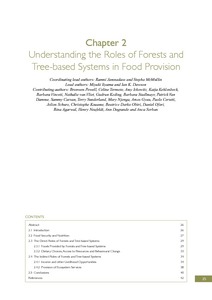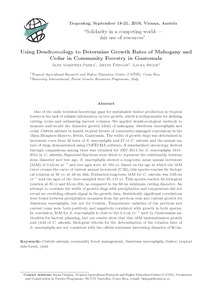forestry
AGROVOC URI: http://aims.fao.org/aos/agrovoc/c_3055
Understanding the roles of forests and tree-based systems in food provision
Forests and other tree-based systems such as agroforestry contribute to food and nutritional security in myriad ways. Directly, trees provide a variety of healthy foods including fruits, leafy vegetables, nuts, seeds and edible oils that can diversify diets and address seasonal food and nutritional gaps. Forests are also sources of a wider range of edible plants and fungi, as well as bushmeat, fish and insects.
Turning ideas into action: planning for non-timber forest product development and conservation
Effective planning for non-timber forest product (NTFP) development and conservation will ensure the most effective use of scarce resources and maximise the likelihood that the objective will be obtained. NTFP development and conservation is usually a long-term activity and involves the collaboration of a number of different, quite independent parties. This has implications for the kind of planning that needs to be undertaken.
Using dendroecology to determine growth rates of mahogany and cedar in community forestry in Guatemala
One of the main technical knowledge gaps for sustainable timber production in tropical forests is the lack of reliable information on tree growth, which is indispensable for defining cutting cycles and estimating harvest volumes. We applied dendroecological methods to measure and model the diameter growth (dbh) of mahogany Swietenia macrophylla and cedar Cedrela odorata in humid tropical forests of community-managed concessions in the Maya Biosphere Reserve, Petén, Guatemala. The width of growth rings was determined in increment cores from 32 trees of S. macrophylla and 27 of C.
When REDD+ goes national: a review of realities, opportunities and challenges
The development of national REDD+ strategies has progressed. Common challenges include establishing appropriate national institutions that link into ongoing processes; ensuring high level government commitment; achieving strong coordination within governments and between state and non-state actors; designing mechanisms to ensure participation and benefit sharing; and establishing monitoring, reporting and verification (MRV) systems. The different agendas of actors involved in policy formulation at the national level reflect those at the international level.
Who’s Forest? Implications of Different Management Regimes for Sustainable Utilisation and Minimisation of Conflicts
This Policy Brief presents some of the lessons learned from research work related to the search for appropriate mechanisms to manage forest resources, and conflicts arising from contested rights to forest resources in eastern and central Africa (ECA).
Wild trees bear fruit
In Mwanza district, Malawi, thirteen villages have, for the last five years, been involved in a project to make fruit juice from indigenous species - Baobab and Tamarind. As a result people in the area are now planting more indigenous trees, rather than cutting them for charcoal and firewood.





